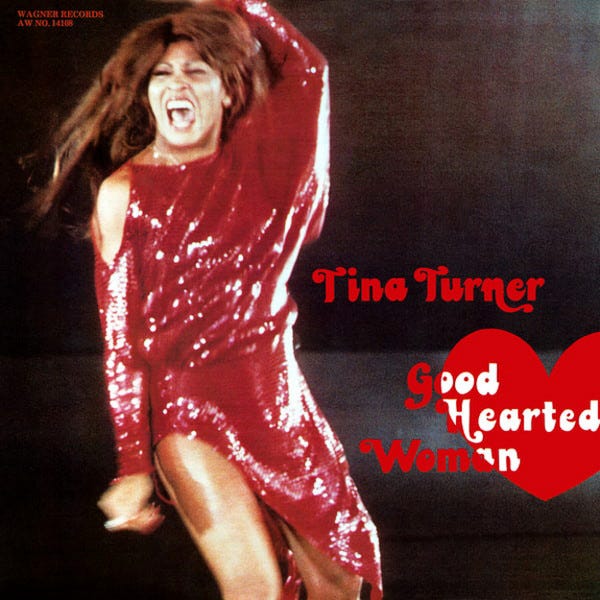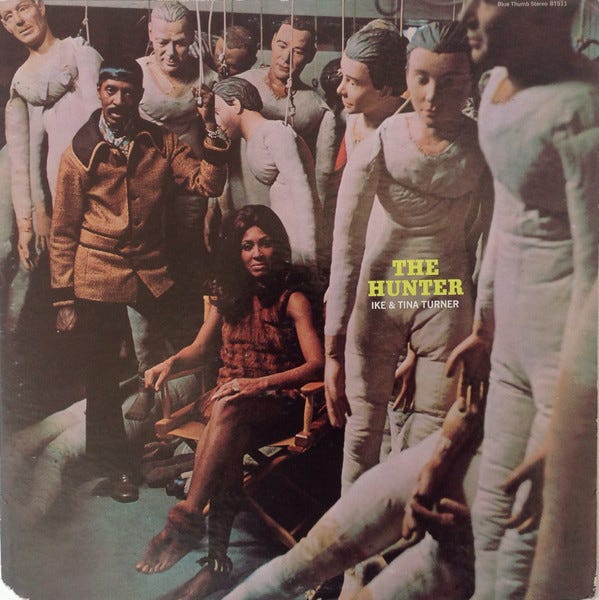The legendary Tina Turner left us last week. She was 83 — a pretty impressive mark to reach for someone who endured as much hardship as she did, though if I’d put my money on anyone living to 100, I would have picked this supreme force of nature whose life and career essentially defined the term “showbiz survivor”.
I honestly can’t put my finger on when I first heard or became aware of Tina Turner. She was just always there, kind of like Bob Dylan or Linda Ronstadt, even though (unlike Bob and Linda) my parents never actually played her records around the house. I didn’t hear the Tommy soundtrack until I was in my teens — and didn’t even see the film ‘til I was in my twenties — so that couldn’t have been the first place I heard her, and I know I never heard 1973’s “Nutbush City Limits” until nearly a decade after it was a hit. And frankly, it’s entirely possible that I heard The Ikettes’ “I’m Blue” on KRLA before I ever heard anything by Ike and Tina Turner.
Likewise, the first non-CCR version of “Proud Mary” I heard was probably not Ike and Tina’s, but rather the one performed on Saturday Night Live in January 1978 by “The Mike and Tina Turner Revue,” featuring Garrett Morris as a very convincing Tina and Michael O’Donoghue as the bad-vibes bandleader who highlights the song’s slow-burning “nice n’ rough” introduction with a grisly tale of a rabbit’s factory accident.
“That wasn’t a very nice story, Mr. Mike,” scolds Tina at the tale’s conclusion.
“I’m not a very nice guy, Tina,” Mr. Mike responds.
The band then performs the whole song in the uptempo Ike and Tina-style arrangement. Morris completely nails Tina’s dance moves, while a sunglassed-and-suited backing trio of Gilda Radner, Jane Curtin and Laraine Newman chime in on the “Rollin’!”s, and Mr. Mike impassively pulls stuffed rabbits from the sound-hole of his acoustic guitar. (I can’t seem to embed a video of the hilarious bit into this post, but you can watch the whole thing here via the Internet Archive.)
I must have only been 11 or 12 when I first saw that skit, and I think I probably got only a fraction of the references (and I likely laughed much louder back then at Mr. Mike’s deadpan gross-out humor than I did at Morris’s note-perfect Tina). But whereas I sometimes had to ask my mom or dad who a SNL bit was spoofing, Tina Turner required absolutely no introduction. Again, it was as if she was just always part of the national landscape, like the Empire State Building or Mt. Rushmore…
I will never forget, however, the first time I heard “River Deep — Mountain High”. In the days following Tina’s passing, I’ve seen several social media threads bagging on the song, with people variously calling it an unlistenable mess, claiming that Ike had forced Tina to record it against her will, decrying Phil Spector’s perfectionist imposition of his thunderous “Wall of Sound” production style upon Tina’s earthy talents, and railing against the white rock critic patriarchy’s decree that this experimental one-off is somehow the defining three minutes and forty seconds of Tina’s career. While some of these points (especially the last one) may indeed be valid, I also believe that if “River Deep — Mountain High” had not been such a major plot point in the arc of the Phil Spector legend (“a staggering work of genius whose commercial failure sent him into seclusion,” etc., etc.), or had gone unreleased for decades, many of these same naysayers would now be posting this same song on Facebook and Twitter with comments along the lines of “OMG YOU HAVE TO HEAR THIS!!!”
Because the first time I heard “River Deep — Mountain High,” it was absent of any context, any background, or any warning for that matter, and it dropped me like a goddamn uppercut to the jaw. I was 13, and sitting in the sun-drenched Laurel Canyon living room of one of my mom’s friends, whose name I unfortunately cannot recall. Knowing I was into “oldies,” he’d asked me if I’d ever heard the song before; and when I said no, he passed me his headphones (the lightweight ‘70s audiophile kind with the yellow foam over the speakers) and instructed me to put them on. He then turned the volume way up on his high-end Marantz receiver, dropped the needle on the 45, and watched with knowing satisfaction as my eyes bugged out in sheer awe and astonishment.
As the record spun, I didn’t hear a talented woman being oppressed by two legendarily awful men; I heard a goddess rising from the murky ocean depths to deliver a pledge of love so fierce and primal that its sheer power must have caused ancient edifices to shake and mountains to implode. Whether or not you hate the backing track and the man responsible for it, Tina’s performance over it is absolutely fucking unassailable; it’s as real and moving as anything that has ever been captured on wax. I think I’m still chasing the high from that initial listen — and, considering how many times “River Deep — Mountain High” has been covered by other artists over the years (though never up to the impossible standard set by Tina), I’m clearly not the only one.
The next important lesson in my Tina Turner education came a few years later, via my friend and mentor Carol Anshaw. Carol’s a fabulously talented novelist and artist, but her influence on me was primarily musical; she turned me on to so much great music in my teens, from George Jones to Motown deep cuts, and she made it her mission to impress upon me that Tina Turner was one of the great live performers of the 20th century. She did this by, among other things, showing me tapes of Gimme Shelter (which features Ike and Tina’s smoking hot performance of Otis Redding’s “I’ve Been Loving You Too Long”) and Tina Turner Live at the Apollo — the latter of which (despite its early ‘80s release date) captured Tina in prime late ‘70s mode, post- “Acid Queen” and pre-Private Dancer. Watching the above hour-long performance, you can totally witness the sheer talent, charisma and force of will that enabled Tina to transform herself from a fugitive battered wife with just a few coins in her pocket into one of music’s biggest and most iconic superstars.
I confess that I never cared much for Tina’s ‘80s mega-comeback period. I was delighted for her success, of course, and certainly didn’t change the channel whenever her videos for “What’s Love Got to Do With It?” or “Better Be Good To Me” popped up on Channel 66, the Chicagoland area’s UHF substitute for MTV circa 1984-85. But musically, that stuff was just too slick and bland and “adult” for me. Far more in my wheelhouse was Ike and Tina’s deeply funky 1969 album The Hunter, which my friend Tracy gave me in 1985 for my 19th birthday.
Yes, Ike was a horrible dude, but he was also a musical genius who recognized the young Annie Mae Bullock’s power as a singer and performer and knew how to properly showcase it and use it to blow the masses’ ever-lovin’ minds. There’s no question that she needed to escape from under his abusive and dictatorial ways — but without Ike’s role in discovering and cultivating her talents, we also wouldn’t be talking about Tina right now. Life and art are complicated like that.
But there’s also no question in my mind that, without Tina, Ike Turner would mostly be remembered today as the guy who wrote “Rocket 88” and the talent scout who brought B.B. King to Modern Records. My favorite cut from The Hunter is “Bold Soul Sister,” a song that is officially credited to Ike, but would be merely a funky trifle without the way Tina completely inhabits it. Watching her strut and smile and do her thing on this 1970 performance of the song from The Ed Sullivan Show is truly life-affirming. I can’t even imagine how many cathode tubes she blew out across the nation that night…
Rest In Peace and Power, Tina. You were quite possibly the boldest soul sister that ever was.







Now finally, you can do what you wanna do Soul Sister, and don’t let anyone--not even God--tell you not to. You’re free at last.
I’m like you, Dan. I remember always knowing who Tina Turner was, but I don’t remember when I first knew her music. And I’ve been obsessed with “River Deep -- Mountain High” for the past month. Her performance of the song, that vocal, has just dug deep into my soul. But there’s more than just Phil Spector vs Ike Turner for the Worst Person in the World. You’ve also got the great Ellie Greenwich writing the song and the Wrecking Crew (with Glen Campbell on guitar and Earl Palmer on drums), creating the wall of sound. Then include the likes of Darlene Love on backing vocals and the song just resonates. I hate that that the song is part of the Phil Spector mythology but I love how Tina so gets to the soul and essence of that song and I listen to it endlessly. RIP Tina. And thanks for writing, Dan.